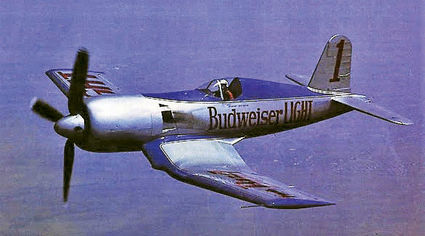Racing warbirds – F4U Corsairs
Short Flights
July 21, 2018
As I get older, I find myself remembering wonderful and crazy things I did in my younger days. Like the time I towed an F4U Corsair fuselage behind a pickup truck from Lancaster Fox Field to Mojave for Gene Akers. He had purchased one of the Corsairs from the Bob Bean Estate and had it stored at Barnes Aviation, sometime in the mid-1970s, I think. He had made arrangements with Richard Willie to keep it at a storage yard he had in Mojave. Keep in mind, this was way before cell phones. My 12-year-old son, Mark, was with me and we traveled on the back roads, avoiding traffic and highways. Amazingly, it was an incident free trip. I certainly wouldn't attempt anything like that today!
The history of these magnificent warbirds is fascinating to me. In 1938, before the U.S. was involved in World War II, the U.S. Navy put out a request for a high-speed, high-altitude fighter aircraft and the design competition commenced.
Chief Design Engineer, Rex Beisel, of Vought Aircraft Industries, Inc. launched a design effort for a new fighter specification calling for use of a powerful 1,500 horsepower Pratt & Whitney R-2800-1, double row, 18 cylinder, air-cooled radial engine. The legendary Igor Sikorsky had been part of the design team for the F4U Corsair.
When the Corsair began flight tests it was the first American fighter to top 400 mph. The XFU-1 Corsair first flight from Stratford, CT was on May 29, 1940.
It was unfortunate that Chauncey (Chance) Milton Vought, one of the most creative American aircraft designers during World War I, didn't live to see the most impressive Naval fighter that bore his company's name. He died from septicemia (blood poisoning) on July 25, 1930, at the age of 40 (aviation pioneer Glenn H. Curtis had passed away just two days earlier).
The most obvious innovation that the design team included was the inverted gull wing, which allowed the use of a 13-foot Hamilton Standard propeller, while still using a normal length main landing gear. Not only did the striking design look graceful, it was efficient too. The landing gear rotates 90-degrees and fits flush up inside the wing.
Later in the war, the U.S. Navy approached Goodyear to build The FG 'Super Corsair' that would have a much larger, more powerful engine – a Pratt & Whitney R-4360 Wasp Major 'corncob' air-cooled engine, with four rows of cylinders, developing nearly 3,000 horsepower. Each row contained seven cylinders and were offset by approximately the width of one cylinder, to allow effective airflow to the next row. Twenty-eight cylinders and 56 spark plugs – gives a whole new meaning to changing the plugs on your airplane engine!

Air racers are firm believers in the phrase, "there's no substitute for horsepower." So, of course the race teams were always modifying engines, clipping wings, changing wingtips, altering canopies, reducing weight or drag and adding bigger engines to go faster.
The first "Super Corsair" I can remember seeing at Reno was the Budweiser LIGHT Corsair piloted by Steve Hinton. He won the Gold Race with this airplane in 1985.
At the time, our family was the "Blue Max" pit crew and we stayed in the pits with our motorhome day and night right next to the airplane. They don't allow that now.
Mark and his best friend, Glen Marshall had the opportunity to be on the ground at one of the pylons during a race. Mark said, "When the Super Corsair would fly over, you could hear the wind whipping around well after the airplane had gone past, it sounded like a tornado! It was so bad that when an aircraft would come up behind the Corsair to make a pass, it would get caught up in the vortex and would cause it to move or dance around fiercely, until he flew past it."
"The Corsair had modified or 'Clipped' wings, which reduced weight and drag and helped it fly faster. However, they had installed wing tips that were rounded off or 'Bobbed.' These wing tips created so much drag that they were actually slowing the airplane down."
"It created an air flow over the surface that would collide back together, actually creating a vortex and was essentially like having a parachute on each wingtip," Mark continued.
"The Bud Light race team remedied this condition by redesigning the wing tip and installed a concaved wingtip, which allowed the air passing over it to blend together, thus relieving the vortex condition and resulting in a much faster aircraft. It went on to win the Gold Race at Reno the following year," he said.
See you on our next flight!





